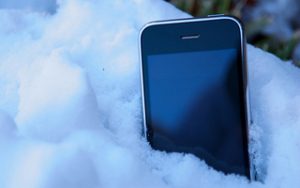Electronics need special care during the cold weather months.
Winter temperatures can wreak havoc on electronics is they are not properly taken care of. While our team of experts advises against leaving any type of electronics in a cold car, the reality is that at one time or another, most of us have been guilty of forgetting a smartphone, laptop, or one of the many other devices that make their way into our cars. In addition to reducing your batteries performance, cold temperatures can cause the device to modify its own ability to regulate temperature. Exposure to colder temperatures will slow down the battery’s electric currents and that in turn speeds up the rate at which it releases its charge. It also provides an environment that encourages condensation that can damage your hard drive. Our team of experts offers these tips for handling a potential disaster due to cold weather conditions: 1. Before starting up your cold laptop or another device, bring it to room temperature to prevent damage to the hard drive. 2. Replace a phone with a cracked screen. If you have ever had a cracked windshield, you’ve noticed that in the cold weather, the crack most likely expanded. The same thing happens to the glass on your phone. If you apply too much pressure, it is possible that the crack will expand and possibly break. Working with a cracked screen is dangerous and should be avoided. 3. If you drop your smartphone or mini in the snow, take it indoors immediately and remove the battery so it can’t ruin electric circuits. Never remove the battery while you’re still outdoors or you risk freezing any water that may have seeped into the battery compartment. 4. If your device uses a SIM card, remove it to save your stored information, like address book, apps, etc. Take a clean microfiber cloth or paper towel and gently dry all surfaces. Next, place your device in an airtight container with packets of silica gel to absorb moisture. If you have no silica gel packets handy, fill a bowl with uncooked rice and bury the device in the rice, which will draw out moisture. 5. Resist the urge to speed up the warming process with a hair dryer or pocket warmer. Doing so can cause the wrong parts of the laptop too warm at an artificial pace and you risk causing it to generate too much heat that can melt internal components. 6. Most importantly, back up your data regularly. Data lost from a hard drive doesn’t have to mean data lost forever. Plan ahead, take precautions to avoid exposure to extremely cold temperatures and keep your devices dry. If you experience basement flooding from sump pump back up or frozen pipes this winter, call the professionals at Thompson Building Associates and ResQ 24. Our trained technicians and state-of-the-art equipment make us a leader in our industry. Our team is available 24 hours a day, seven days a week. 614-863-9650. 3333 Refugee Road Columbus, OH 43232 https://thompsonbuilding.com/

